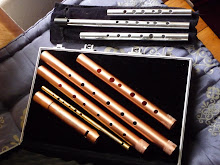 Being married to the band's soundman, I get the opportunity to learn the technical aspects of making amplified music sound good. Since we are doing our own recording, there is a whole new world of research to explore. In this case, the research done to find D2's birthday speakers also netted the band a pair of monitors to be used specifically for mixing.
Being married to the band's soundman, I get the opportunity to learn the technical aspects of making amplified music sound good. Since we are doing our own recording, there is a whole new world of research to explore. In this case, the research done to find D2's birthday speakers also netted the band a pair of monitors to be used specifically for mixing.The problem with most speakers/monitors is that they actually contribute to the sound that you hear. For example, if you have ever played a CD in your stereo (car or house) and then taken it to a different stereo, you will know some of what I mean. Even if you matched systems and EQs, different speakers actually could make the music sound different.
Normally, this is a bit odd, but not a huge issue. However, if you are the band mixing tracks together so that the cello and penny whistle come out in front here but get buried behind the vocals there, for example, it is pretty important that the monitors don't do that. These monitors are "flat" in that they just transmit the sound as purely as possible without adding or subtracting anything.
 In other words, if you want to also use these - purely hypothetically you understand - as your computer desktop speakers so that your 15 year old son doesn't have the best speakers in the house, then you would need to be a sound man. Most people have a standing preference on how their music sounds (more mids, less bass, more treble, whatever) - but there are an infinite number of ways to record sound. So, to get every different CD sounding the way you want with these speakers, you might have to change the EQ on each one. Most people just buy some speakers that color the music in the areas that they find appealing.
In other words, if you want to also use these - purely hypothetically you understand - as your computer desktop speakers so that your 15 year old son doesn't have the best speakers in the house, then you would need to be a sound man. Most people have a standing preference on how their music sounds (more mids, less bass, more treble, whatever) - but there are an infinite number of ways to record sound. So, to get every different CD sounding the way you want with these speakers, you might have to change the EQ on each one. Most people just buy some speakers that color the music in the areas that they find appealing.Of course, in my head, this is related to my "have to reduction" idea, too. The fact of the matter is that reducing have tos is a social problem, because most of our have tos are basically the things we prefer. They are either a) expressions of our values or b) something we just haven't bothered to think about. (And really b) is a subset of a) because not thinking about it means that it isn't very high on our list of priorities.) So, to reduce our have tos, we have to decide to think about them and then sort them all out according to our individual values. Speaking as a Have To Reduction Consultant to-be, it is pretty important that I figure out how to convince people that the process is value added. Otherwise, I should just invest in a list of areas that match different shadings of have tos - just like all of those different speakers match the common sound preferences. Tricky, yes?

1 comment:
Yes I am a man of sound mind and actions! I just happen to be a little twisted when it comes to audio. After all I like to watch sound waves created more than I like to hear the music. With that said as you can see in the pictures my audio monitors are now almost as big as my video monitor so what does that mean? You guessed it - a much bigger video monitor! As for that whole thing of having bigger audio monitors than my son I have first hand confirmation from a well known teacher at the Conservatory of Music that, and I quote "WE CANNOT HAVE THAT! PERIOD!!!!!!" So it is no fault of my own that I have the bigger set of monitors I am only follow my teacher's explicit instructions!
Post a Comment